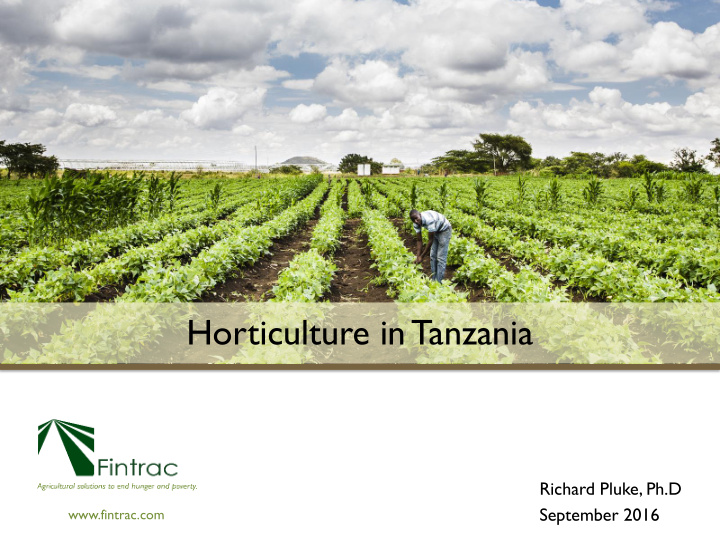



Horticulture in Tanzania Richard Pluke, Ph.D September 2016 www.fintrac.com
Agricultural solutions to end hunger and poverty
Agricultural solutions to end hunger and poverty
Agricultural solutions to end hunger and poverty
State of Horticulture in 2009 Formal horticulture sector focused on Kenyan expansion initiatives in the north. US and Dutch government prioritized smallholder production, initially through outgrower programs for exporters. Low levels of production (5-10 tonnes/ha.) and haphazard use of inputs Poor extension services and no functioning value chain. Smallholder farmers selling to buyers through spot transactions. Unpredictable. Local wholesale markets dominated by traders & brokers. Large postharvest losses. Agricultural solutions to end hunger and poverty
Production Agricultural solutions to end hunger and poverty
Postharvest Agricultural solutions to end hunger and poverty
Initial Focus on Improved Production & Markets Production Capacity build field technicians - boot camps, programmed field support, regular trainings. Facilitate their full time work in the field – transport & equipment; establish routes Supervise field technicians – structure field team to provide strong field supervision; set targets; daily recording of field activities; weekly/monthly analysis of performance. Quarterly production meetings. Use of on-farm demonstration plots to introduce GAPs and technologies Use of grants program to embed technicians into the value chain Agricultural solutions to end hunger and poverty
Improved Production Agricultural solutions to end hunger and poverty
Initial Focus on Improved Production & Markets Technologies Agricultural solutions to end hunger and poverty
Better Practices and Technologies Agricultural solutions to end hunger and poverty
Better Practices and Technologies Average yield increase: 203% Average gross margins: $3,906 per hectare/crop cycle. Agricultural solutions to end hunger and poverty
Initial Focus on Improved Production & Markets Markets Recruit market specialists to identify and evaluate potential buyers. Develop a vetted buyer database and share with farmers. Use the grants program to expand the efforts of existing buyers and strengthen the relationship. Enable local horticulture association to collect market price data Improved production = improved prices Agricultural solutions to end hunger and poverty
Facilitate ‘Crowding In’ & Sustainability Community field days to stimulate farmers & agricultural companies. Agricultural solutions to end hunger and poverty
Facilitate ‘Crowding In’ & Sustainability Use grant funds to partner with agroinput companies to expand products, distribution network and extension services. Agricultural solutions to end hunger and poverty
Facilitate ‘Crowding In’ & Sustainability Practical Training Centers at agriculture universities/colleges: Kizimbani, Zanzibar Horti Tengeru, Arusha SUA, Morogoro Agricultural solutions to end hunger and poverty
Facilitate ‘Crowding In’ & Sustainability Feed The Future intends to sustainably reduce global poverty and hunger on a broad scale. FTF’s aspirational goal is for a 20% reduction in the prevalence of extreme poverty by 2017. In the Tanzanian ZOI, this requires that 1 million people earn an extra 25 cents a day (or a total of $91M per year). TAPP’s directly measured results were impressive over 6 years – 61,600 HHs & $91M incremental sales – but still far from what’s needed. Post-project review shows that the improved production practices and expansion of services, inputs and markets continues. Agricultural solutions to end hunger and poverty
Lessons Learned Production The technology package was simple for farmers to adopt and mostly affordable. To • reach scale, the tech package must be validated and formally adopted by a broad range of stakeholders working in the field. Research component. Failures occurred due to lack of planning and being unprepared at the critical • production points. Needs to be addressed in extension programs. • Horticulture is knowledge/skill intensive and it rewards those who learn the craft. Marketing • Quality produce separates itself in the market because it makes more money for everybody involved. Agro-input companies • Need to ‘prime the pump’ before getting these companies to make big plays. • An embedded extension program has management costs for the SMEs Agricultural solutions to end hunger and poverty
FtF Horticulture in E. Africa Continued support for horticulture • Promotion of ‘Market Access’ approach by contractors • • Focus on accelerated adoption of technologies • Focus on youth and the employment and income generation opportunities • Integration of horticulture into nutrition initiatives • Capacity building of SMEs in the VC Recommendations • Continue extension and sensitization programs to reach a tipping point in the adoption of improved production practices and commercial philosophies Support the growth & maturation of the value chain (e.g. training & certification • of service providers) while promoting opportunities for women and youth. • Integrate F&V nutrition initiatives into broader community programs & understand their utilization better. Measure: indirect impacts, SMEs involvement & effectiveness. • Agricultural solutions to end hunger and poverty
Agricultural solutions to end hunger and poverty
Recommend
More recommend